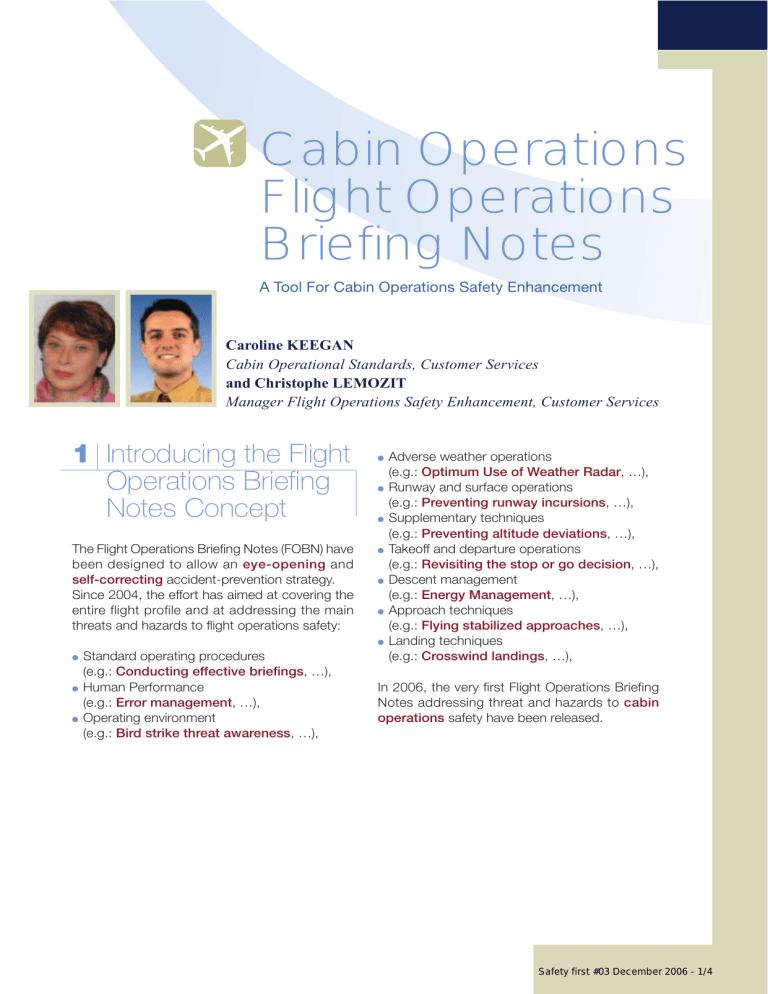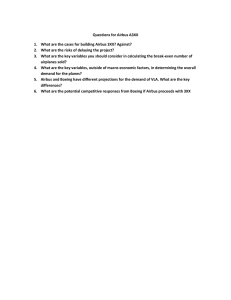
Cabin Operations
Flight Operations
Briefing Notes
A Tool For Cabin Operations Safety Enhancement
Caroline KEEGAN
Cabin Operational Standards, Customer Services
and Christophe LEMOZIT
Manager Flight Operations Safety Enhancement, Customer Services
1 Introducing the Flight
Operations Briefing
Notes Concept
The Flight Operations Briefing Notes (FOBN) have
been designed to allow an eye-opening and
self-correcting accident-prevention strategy.
Since 2004, the effort has aimed at covering the
entire flight profile and at addressing the main
threats and hazards to flight operations safety:
Standard operating procedures
(e.g.: Conducting effective briefings, …),
Human Performance
(e.g.: Error management, …),
Operating environment
(e.g.: Bird strike threat awareness, …),
Adverse weather operations
(e.g.: Optimum Use of Weather Radar, …),
Runway and surface operations
(e.g.: Preventing runway incursions, …),
Supplementary techniques
(e.g.: Preventing altitude deviations, …),
Takeoff and departure operations
(e.g.: Revisiting the stop or go decision, …),
Descent management
(e.g.: Energy Management, …),
Approach techniques
(e.g.: Flying stabilized approaches, …),
Landing techniques
(e.g.: Crosswind landings, …),
In 2006, the very first Flight Operations Briefing
Notes addressing threat and hazards to cabin
operations safety have been released.
Safety first #03 December 2006 - 1/4
2 Cabin Operations
Domain
This new Cabin Operations domain of the Flight
Operations Briefing Notes has been created to
meet the respective needs of cabin crewmembers
first, then of flight crewmembers and of other flight
operations personnel.
The cabin operations domain provides an overview
of the following aspects that need to be understood
and mastered in order to enhance cabin operations
safety:
Effective Briefings for Cabin Operations
Crew Communication
Dangerous Goods
Ground Operations Safety
Cabin Smoke Awareness
Managing In-Flight Fires
Ditching
Decompression
Turbulence
Planned Ground Evacuation
Unplanned Ground Evacuation
Precautionary Evacuation
Cabin crew managers and training instructors
should review, customize (as required) and
implement the recommendations, guidelines and
awareness information, in the following domains:
Cabin operational documentation
Training
Information (Cabin crew bulletins, Airline’s safety
magazine articles, Classroom lectures; and/or
Stand-alone reading).
Safety first #03 December 2006 - 2/4
Line cabin crew should review and compare the
recommendations, guidelines and awareness
information with their current practices and enhance
their techniques and awareness level, as required.
The cabin operations domain is an ideal
complement of the Getting to Grips with Cabin
Safety brochure released in 2005.
Such safety awareness references provide operators
with guidance to implement their own cabin safety
program.
If you have access rights, go to «Secure area» (top
left of home page) / «Customer login» / «Flight
Operations (Home)» (on left). To obtain access
rights, contact your IT administrator or refer to
«Registration information» (top left).
The Flight Operations Briefing Notes are also
released on the Safety Library room of the Airbus
Safety First website
http://www.airbus.com/en/corporate/ethics/safety_lib/
Where to consult/download them?
The Flight Operations Briefing Notes and all other
safety and operational expertise publications
(e.g. Getting to Grips with …) are regularly
released on the Flight Operations Portal,
which can be found in the secure area of
www.airbusworld.com.
CONTACT DETAILS
AIRBUS
Caroline KEEGAN
Cabin Operational Standards
Customer Services,
Flight Operations Support & Services
Tel:+33 (0)5 67 19 03 59
Fax: +33 (0)5 61 93 29 68
caroline.keegan@airbus.com
Christophe LEMOZIT
Manager Flight Operations Safety
Enhancement
Customer Services,
Flight Operations Support & Services
Tel.:+33 (0)5 62 11 82 90
Fax: +33 (0)5 61 93 29 68
christophe.lemozit@airbus.com
Safety first #03 December 2006 - 3/4
Safety First
The Airbus Safety Magazine
For the enhancement of safe flight through
increased knowledge and communications.
Safety First is published by the Flight Safety Department
of Airbus. It is a source of specialist safety information
for the restricted use of flight and ground crew members
who fly and maintain Airbus aircraft. It is also distributed
to other selected organisations.
requirements or technical orders. The contents do not
supersede any requirements mandated by the State of
Registry of the Operator’s aircraft or supersede or amend
any Airbus type-specific AFM, AMM, FCOM, MEL
documentation or any other approved documentation.
Material for publication is obtained from multiple sources
and includes selected information from the Airbus Flight
Safety Confidential Reporting System, incident and
accident investigation reports, system tests and flight
tests. Material is also obtained from sources within the
airline industry, studies and reports from government
agencies and other aviation sources.
Articles may be reprinted without permission, except where
copyright source is indicated, but with acknowledgement
to Airbus. Where Airbus is not the author, the contents of
the article do not necessarily reflect the views of Airbus,
neither do they indicate Company policy.
All articles in Safety First are presented for information
only and are not intended to replace ICAO guidelines,
standards or recommended practices, operator-mandated
Contributions, comment and feedback are welcome. For
technical reasons the editors may be required to make editorial
changes to manuscripts, however every effort will be made
to preserve the intended meaning of the original. Enquiries
related to this publication should be addressed to:
Airbus
Product Safety department (GS)
1, rond point Maurice Bellonte
31707 Blagnac Cedex - France
Fax: +33(0)5 61 93 44 29
safetycommunication@airbus.com
Safety First
# 03 December 2006
Safety First is published
by Airbus S.A.S
1, rond point Maurice Bellonte
31707 Blagnac Cedex / France
Editors:
Yannick Malinge,
Vice President Flight Safety
Christopher Courtenay,
Director of Flight Safety
© Airbus S.A.S. 2006 – All rights reserved. Confidential and proprietary documents.
By taking delivery of this Brochure (hereafter “Brochure”), you accept on behalf of your
company to comply with the following guidelines:
3 No other intellectual property rights are granted by the delivery of this Brochure than the
right to read it, for the sole purpose of information.
Concept Design by
HCSGM 20061317
Producted by Quat’coul
3 This Brochure and its content shall not be modified and its illustrations and photos shall
not be reproduced without prior written consent of Airbus.
Copyright: GSE
3 This Brochure and the materials it contains shall not, in whole or in part, be sold,
rented, or licensed to any third party subject to payment.
Photos copyright Airbus
Photos by ExM:
Hervé Berenger
Philippe Masclet
Hervé Goussé
This Brochure contains sensitive information that is correct at the time of going to press.
This information involves a number of factors that could change over time, effecting the
true public representation. Airbus assumes no obligation to update any information contained
in this document or with respect to the information described herein.
Printed in France
Airbus SAS shall assume no liability for any damage in connection with the use of this
Brochure and of the materials it contains, even if Airbus SAS has been advised of the
likelihood of such damages.
Safety first #03 December 2006 - 4/4

